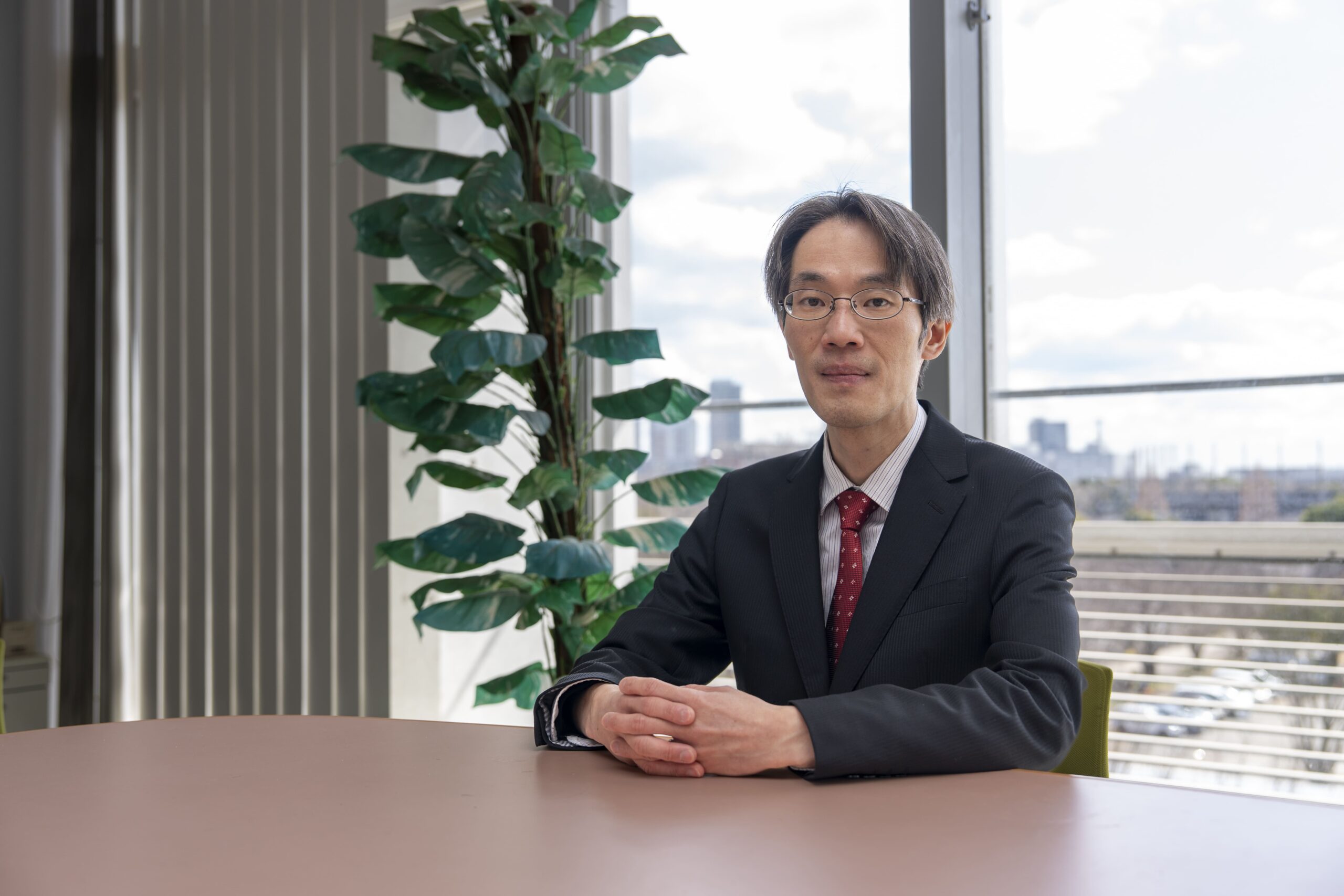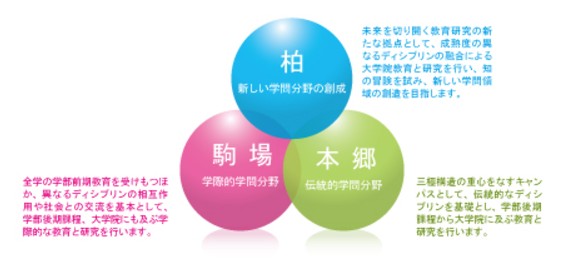WELCOME TO THE ADVANCED MATERIALS SCIENCE
The Department of Advanced Materials Science (AMS) consists of the three majors of the Graduate School of Engineering, “Applied Physics”, “Materials Engineering”, and “Applied Chemistry”, and the Institute for Solid State Physics participates as a cooperative course. It was established in April 1999 as one of the four majors in the Graduate School of Frontier Sciences (GSFS), the University of Tokyo. So far, we have been working as a new 21st century graduate school major at this Kashiwa campus. Currently, we become the world’s largest research center for interdisciplinary materials science research bases and are implementing leading materials science research, which has been done in collaboration with RIKEN, National Institute of Advanced Industrial Science and Technology (AIST), National Institute for Materials Science (NIMS), SPring-8 (synchrotron radiation facility), and Nano-Terrace (3GeV high-brilliance synchrotron radiation facility).

DIRECTOR GREETINGS
The world around us is changing rapidly. To address the complex challenges we face, it is essential to accelerate the advancement of science and technology.
Even in today’s age—where artificial intelligence has become commonplace—the significance of materials science remains immeasurable. In this field, groundbreaking concepts are being developed every day, and cultivating human resources with advanced expertise is more important than ever.
The Department of Materials Science and Engineering offers a carefully structured curriculum designed to nurture world-class talent.
In our individual laboratories, we conduct cutting-edge research spanning a wide range of topics, from the synthesis of advanced materials and ultra-precise measurements to the theoretical elucidation of phenomena and the prototyping of novel devices.
We also provide personalized education tailored to each student’s interests and disposition.
Why not join us and experience the excitement of being at the forefront of future technologies?
Yoshiaki Sugimoto
AMS COURSE
The “material” we are dealing with is a many-body system formed by the astronomical numbers (~ 10 to the 23rd power) of nanoscale components like nuclei and electrons. To date, research has been conducted to understand and apply the diverse phenomena exhibited by various functional materials. However, the degree of freedom that we can currently handle is only a small part of the astronomical degree of freedom in many-body systems. The goal of AMS is to develop a stage that can control unexplored degrees of freedom in materials science, and to explore unprecedent phenomena and functionalities. Pioneering application fields in materials science can contribute to the development of human society. To achieve these goals, we conduct research under the following three approaches.

THREE-POLE STRUCTURE
In contrast to the Hongo Campus, which aims to inherit and develop its specialized fields, and the Komaba Campus, whose mission is interdisciplinary education and research, the Kashiwa Campus offers cross-disciplinary education that is retroactively reorganized based on existing specialized fields. We pursue research, that is, “adventure of knowledge”.
By enriching the Kashiwa Campus as the third “pole” following Hongo and Komaba, the tripolar structure that the University of Tokyo is aiming for will be completed.
EDUCATIONAL RESEARCH PURPOSE
In the Department of Materials Science, we will explore the undeveloped degrees of freedom of materials that are composed of astronomical numbers of electrons and atomic nuclei and have various degrees of freedom, explore new phenomena, and build new views of matter. Promote research with the aim of developing these applications.
Through the practice of leading research at the frontier of material science and comprehensive and systematic wide-ranging physical education, we have a cross-disciplinary perspective and creative problem-solving ability based on advanced expertise, and next-generation society and science. To develop human resources who will lead the way. The Department of Materials Science consists of the three majors of the Graduate School of Engineering, “Physical Engineering”, “Materials Engineering”, and “Applied Chemistry”, and the Institute for Solid State Physics participates as a cooperative course. It was newly established in April 1999 as one of the four majors in the Graduate School of Frontier Sciences, the University of Tokyo.
So far, I have been working as a new 21st century graduate school major at this Kashiwa campus.
Currently, in collaboration with RIKEN, Industrial Technology Research Institute, Material and Materials Research Organization, SPring-8 (synchrotron radiation facility), and Nano-Terrace (3GeV high-brilliance synchrotron radiation facility), it is based on physics, chemistry, materials science, applied physics, and applied chemistry. It has become the world’s largest research center for integrated materials science and is practicing leading material science research.
In this fulfilling environment, we are conducting a new type of material science education based on academic fusion, aiming to develop researchers and engineers who can play an active role on the international stage in the future.
Let’s learn and practice cutting-edge science and disseminate it to the world under the various elite professors of this major.
Creation of an Attractive Platform for New Phenomena, and New Functions
We are opening up a new world of materials science by utilizing wider variations of functional materials and their aggregation, such as strongly correlated electronic materials, semiconductor superstructures, and organic molecule, which will be an indispensable building block in future electronics, photonics and spintronics, soft matters including biological materials with aperiodic hierarchical structures, and interfaces formed by nanoclusters, solids, liquids and gasses.
Detection and Control of Nanoscale Phenomena beyond Macroscopic Observations
We conduct material science research based on cutting-edge technologies, such as scanning tunneling microscopes, high-resolution electron microscopes, quantum beams such as synchrotron radiation and neutron beams, ultrafast pulse lasers, and first-principles simulations.
Observation of non-equilibrium states under extreme conditions created by ultra-strong magnetic fields, extremely low temperatures, ultra-high pressures, laser excitation, and plasma
We are developing methods to generate and detect various extreme states and non-equilibrium states, as well as constructing theories to understand them, by which many-body effects in materials, such as strongly correlated electron systems, can be elucidated.
The Goal of Applied Physics
The goal of Applied Physics is to develop a stage = “new material” that can manipulate undeveloped degrees of freedom, to explore unknown phenomena created from that stage and to bring out excellent functions, and to bring out its excellent functions. The purpose is to contribute to the development of human society by elucidating the mechanisms and developing application fields for these phenomena and functions.
AMS (Advanced Materials Science)
Department Office
AMS (Advanced Materials Science),
Graduate School of Frontier Sciences,
The University of Tokyo
Kashiwanoha 5-1-5, Kashiwa, Chiba 277-8561, Japan
Email : ams-office(at)ams.k.u-tokyo.ac.jp
Please change (at) to @.
